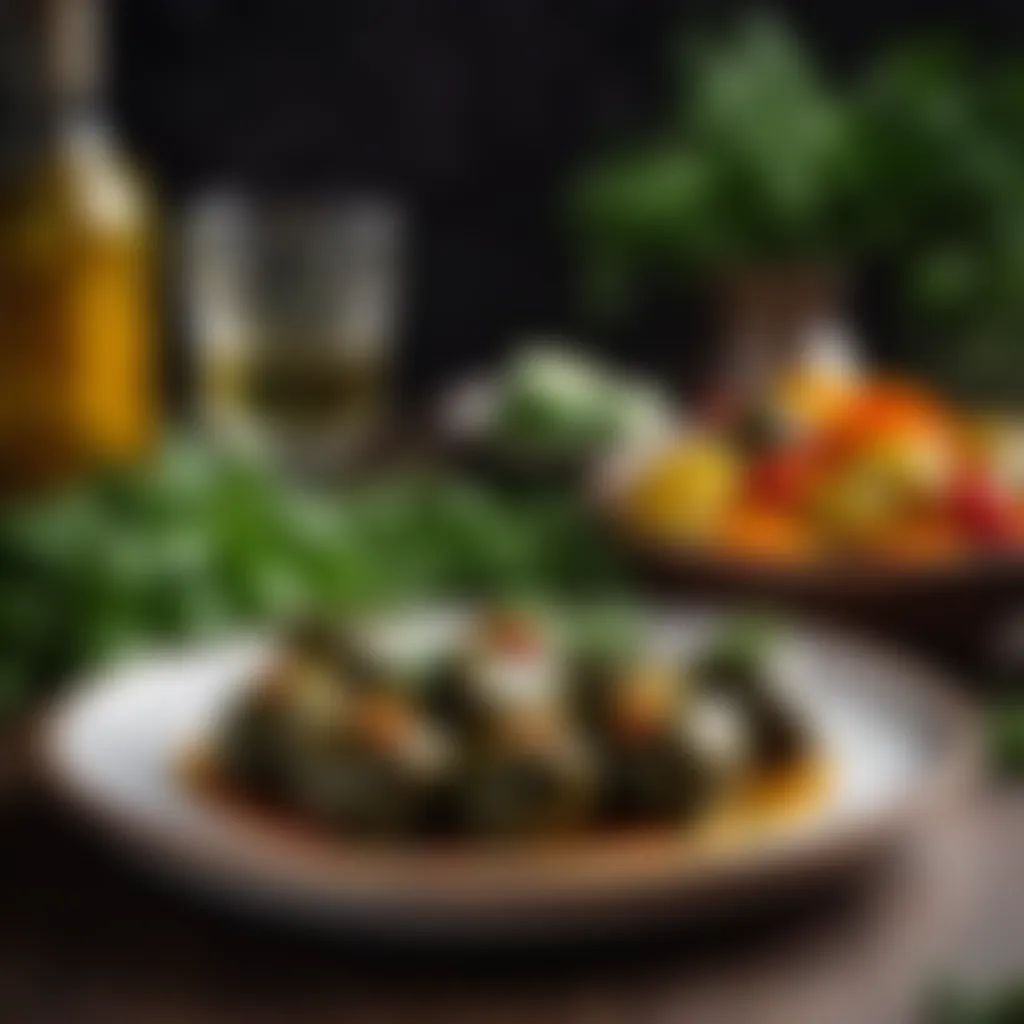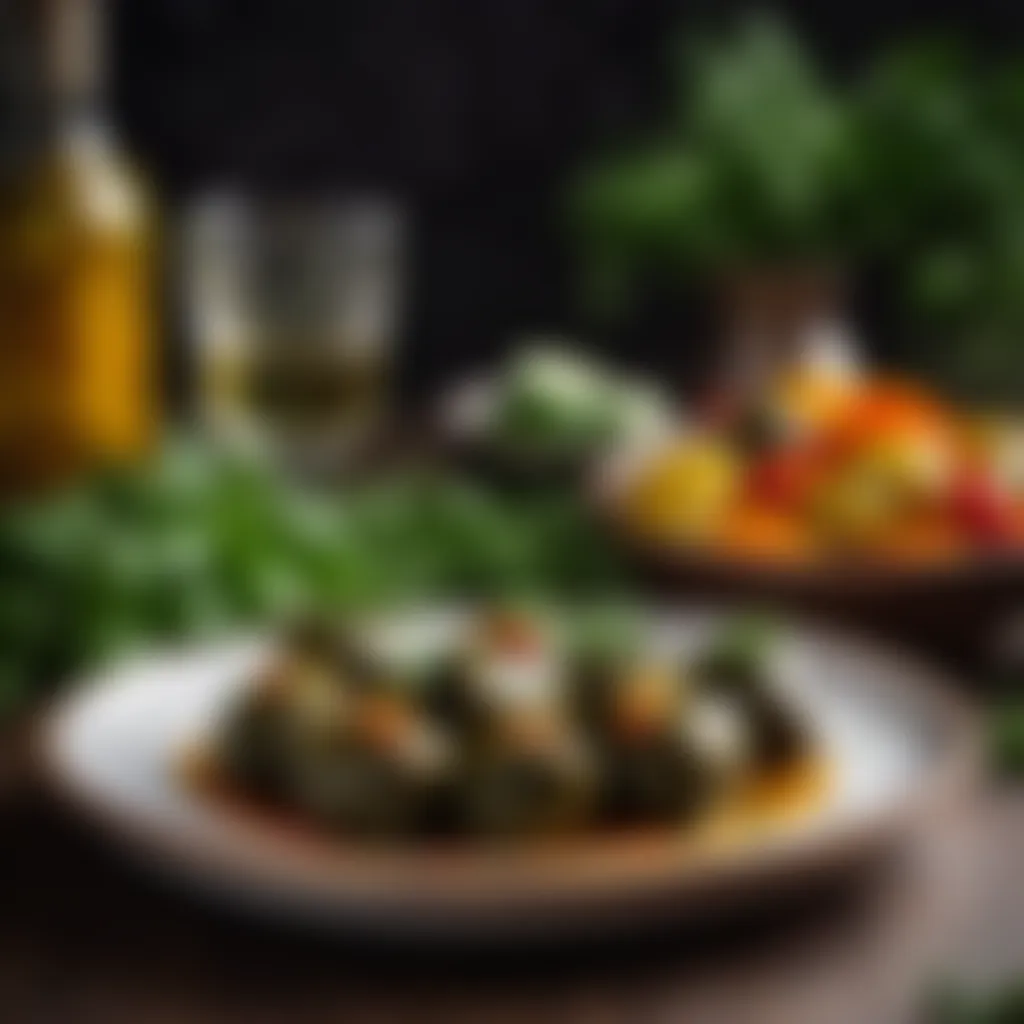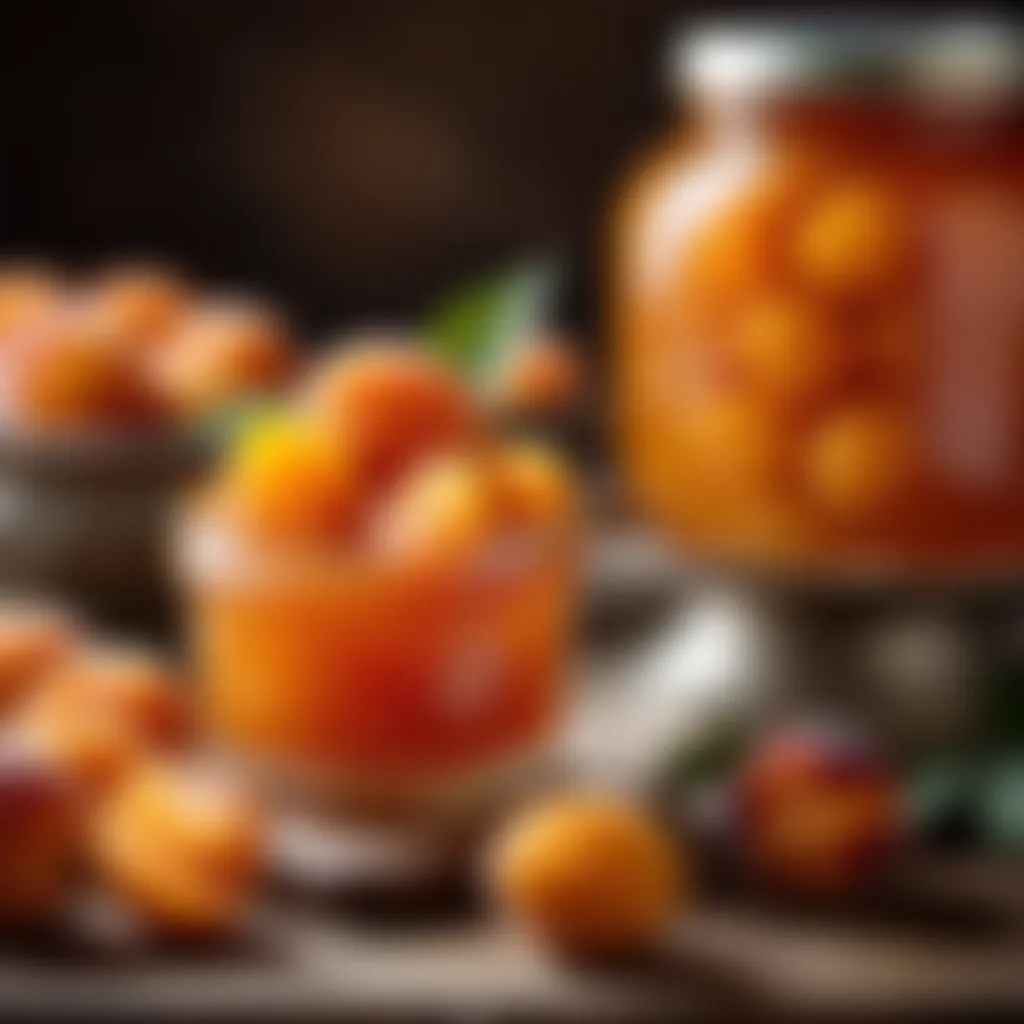Discover the Rich Tapestry of Armenian Cuisine


Intro
Embarking on a culinary journey into the heart of Armenian cuisine is akin to taking a stroll through the rich tapestry of its history and culture. The aromatic spices, fresh ingredients, and time-honored recipes tell stories of the land and the people who've been shaped by it. In the hands of a skilled cook, authentic Armenian recipes transform simple elements into culinary masterpieces.
When someone mentions Armenian cooking, dishes like khorovats and dolma might leap to mind, but the true palate of Armenia extends far beyond these. Each recipe encapsulates the essence of tradition, showcasing not only flavors but also the narratives of family gatherings and festive celebrations. This article aims to provide you, the home cook, with an in-depth understanding of the key components that make up the delightful world of Armenian recipes.
To start this culinary adventure, understanding the fundamental ingredients is crucial. The following section will lay the groundwork for the recipes that celebrate Armenian heritage, offering everything you need to start your cooking journey.
An Overview of Armenian Cuisine
Armenian cuisine offers a fascinating glimpse into the rich tapestry of the nation's history and culture. It's more than just food; it reflects the collective identity of the Armenian people. Historically, Armenia has struggled for its autonomy and culture amid various empires and neighboring influences. The food, therefore, becomes a medium of preserving the Armenian spirit. Each dish tells a story, encapsulating tradition and recipes passed down through generations.
Historical Context
The roots of Armenian cuisine can be traced back thousands of years. The land’s fertile soil has nourished a variety of crops, making it a beacon for agriculture. People took what they had available, matched it with local customs, and created unique dishes that have stood the test of time. During the ancient era, trade routes allowed Armenia to be a melting pot for various cooking techniques and ingredients. Notably, the Silk Road connecting East and West played a significant role in introducing spices and flavors that are integral to modern Armenian dishes today. Even today, recipes often highlight ancient grains, which carry an echo of the past into the present culinary landscape.
Influences from Neighboring Regions
Armenia's geographical position has painted a rich narrative in its culinary style. Its neighbors include Turkey, Iran, and Georgia, all of which have left their mark on Armenian cooking. For instance, the use of fresh herbs aligns closely with Persian cooking, while the grilling techniques might be similar to Georgian khachapuri preparation.
- Turkish Influence: The famous dolma, a dish of stuffed vegetables, showcases a certain Turkish touch, though Armenians have their twist by stuffing it with rice, lamb, and a medley of spices unique to their culture.
- Iranian Influence: The aroma of saffron and the use of pomegranates in some dishes is a nod to Armenian cooking’s Persian influences.
- Georgian Influence: Techniques like grilling meats over open flames, known as khorovats, are akin to those found in Georgian cuisine, yet seasoned differently to represent Armenian traditions.
Cultural Significance of Food
Food plays a central role in Armenian culture, symbolizing community, hospitality, and tradition. When families share meals, it becomes an act of love and connection. Festive gatherings are incomplete without an array of dishes, where each item represents a piece of the family’s heritage.
"In Armenia, a guest is a gift from God" – this saying captures the value placed on hospitality and the deep-seated tradition of sharing meals.
Each festive occasion, from weddings to holidays, brings forth distinct dishes that embody specific meanings. For example, during the church’s Vardavar festival, water is splashed around for celebration, and families make sweet pastries to sweeten the spirit.
Through these meals, recipes are a form of storytelling. They carry family history, cultural pride, and spiritual significance, instilling a sense of identity.
In essence, taking the journey through Armenian cuisine reveals the marriage between the flavors of the earth and the heart's longing for togetherness. It’s this aspect that makes Armenian food not merely a source of sustenance but a vital thread woven into the fabric of its society.
Essential Ingredients in Armenian Cooking
When we talk about Armenian cooking, the ingredients play a pivotal role in bringing the culture and regional flavors to life. Without a doubt, the richness found in Armenian dishes stems from these essential elements. A focus on these ingredients equips any home cook with the necessary knowledge to create authentic meals that truly reflect Armenian heritage. In this section, we'll delve into key components that define the cuisine, highlighting not just their flavors but also their significance in traditional recipes.
Traditional Spices and Herbs
In Armenian cuisine, spices and herbs are akin to the soul of the dish. They add layers of flavor and depth, transforming simple ingredients into a sensory experience. Some of the favorite spices include sumac, which adds a tangy zest, and cumin, renowned for its warm, earthy aroma. The use of fragrant fresh herbs like parsley, cilantro, and dill brings a refreshing touch to various recipes.
"The right mix can make or break a dish. It's all about balance."
Further, paprika—notably sweet varieties—pops up in numerous recipes, lending a vibrant color and subtle heat. It’s not rare for a traditional Armenian dish to include a pinch of allspice or the bright warmth of cinnamon, elevating both sweet and savory offerings. Understanding the art of these spices enables a housewife to replicate cherished family dishes with authenticity.
Staple Foods: Grains and Legumes
At the foundation of Armenian meals lies a variety of grains and legumes that not only serve as filling staples, but also embrace the nutritional benefits they offer. Lentils are particularly adored, used frequently in stews and salads, providing protein and a hearty texture. In tandem with lentils, chickpeas make an appearance, whether in classic dishes or innovative modern twists.
Wheat flour plays a leading role—it’s the base for lavash, that traditional Armenian flatbread that finds its way to every meal. The process of making lavash is a beautiful tradition in itself, often involving the entire family.
Armenians also embrace rice, particularly in pilafs studded with nuts and dried fruits, making for a perfect accompaniment to grilled meats. It’s truly fascinating how these simple ingredients carry the weight of history, nourishment, and community around the dining table.
Cheeses and Dairy Products
In keeping with the love for hearty meals, Armenian cuisine celebrates its diverse range of dairy products. From tangy yogurt to the aromatic cheese called chechil, these ingredients enrich the culinary landscape significantly. Traditional Armenian cheese, such as kashkaval, is often incorporated into dishes or simply enjoyed with bread.
Yogurt isn't just a side condiment; it’s also a base for tasty sauces or even mixed into soups. It adds creaminess and a bit of tartness that perfectly complements hearty main dishes. One may often find yogurt used in refreshing salads, making them more vibrant and enjoyable.
Overall, understanding and utilizing these essential ingredients equips any aspiring cook to craft an authentic Armenian meal that resonates with the heart and history of this vibrant culture.
Iconic Armenian Dishes


When discussing Armenian cuisine, it's impossible to overlook the significance of its iconic dishes. These culinary creations serve as more than just meals; they embody the rich history, traditions, and the spirit of a nation. Each dish tells a story, often passed down through families, capturing the essence of heritage. By exploring iconic Armenian dishes, one not only appreciates their unique flavors but also delves into the cultural fabric that weaves the Armenian people together.
Khorovats: Armenian Barbecue
Khorovats is the heart of Armenian celebration. Imagine a lively gathering, with the scent of marinated meats wafting in the air. This dish is not only popular but almost sacred in its representation of communal bonding. Usually made with pork, lamb, or chicken, these skewered meats are marinated with a variety of spices, often including salt, pepper, and garlic, then grilled to perfection over charcoal. The preparation is a ritual; it's all about patience and skill, ensuring the meat is tender and infused with flavor. Traditionally, it's paired with fresh veggies like tomatoes and bell peppers or lavash, allowing you to wrap bites in the warm bread for a mouthwatering experience.
Dolma: Stuffed Vegetables
Dolma holds a special place in Armenian cuisine as an array of flavorful stuffed vegetables. This dish typically consists of grape leaves or bell peppers filled with a mixture of rice, minced meat, and aromatic spices. Each family might have its twist on the filling, adding personal secrets through generations. The gentle simmering in a tomato sauce or broth brings all these flavors together. It's not just about feeding the belly; it’s a way of sharing heritage and nostalgia. Serving dolma during holidays or family gatherings signifies a warm welcome. The dish transcends mere sustenance, becoming a symbol of togetherness through its rich, savory taste.
Basturma: Cured Meats
In the realm of Armenian delicacies, basturma stands out as a labor of love. This air-dried cured meat, usually made from beef, undergoes an elaborate preparation process. The meat is coated with a mix of crushed garlic and fenugreek, then pressed, salted, and aged. The result is a bold, robust flavor that is simply irreplaceable. It’s common to enjoy basturma thinly sliced, often served with cheese or bread, as part of a meze platter. This dish not only showcases preservation techniques but also embodies the meticulous nature of Armenian cooking, where nothing goes to waste. The flavors and techniques encapsulated in basturma represent the creativity and resourcefulness of Armenian culinary traditions.
Lahmajoun: Armenian Pizza
Often referred to as Armenian pizza, lahmajoun is a delightful thin crust topped with a savory mix of minced meat, vegetables, and spices. It's a bustling street food favorite, perfect for those on the go, yet often lovingly prepared at home for family gatherings. The various toppings are seasoned nicely, creating a perfect harmony of flavors. Baking it in a hot oven gives the crust a delicate crispiness while keeping the topping juicy. It's commonly enjoyed rolled up with a splash of lemon juice or with fresh herbs. Lahmajoun is more than food; it’s a festive experience, often bringing families together to share in its deliciousness.
Whether simmering dolma, grilling khorovats, or preparing lahmajoun, every iconic Armenian dish contributes to a larger narrative that celebrates community, family, and tradition.
By embracing these iconic dishes, one not only savors the rich culinary flavors but also connects with the Armenian culture in an unforgettable way.
Traditional Cooking Techniques
In Armenian cuisine, traditional cooking techniques form the very backbone of each recipe, imparting not just flavor but also cultural significance. These methods have been passed down through generations, reflecting the rich history and resourcefulness of the Armenian people. Understanding these techniques allows home cooks to connect with their heritage and elevate their culinary skills. Each approach has its unique merits, and by embracing them, one not only prepares dishes that taste authentic but also engages in a nurturing, communal experience.
Grilling and Roasting
Grilling and roasting are popular methods in Armenian kitchens, vividly bringing out the richness of flavors. Khorovats, the acclaimed Armenian barbecue, showcases these techniques beautifully. Whether you are grilling marinated meats or vegetables, the open flame imbues a smoky savor that is hard to replicate with other methods. It’s not just about cooking; it's an endless dance of heat and flavor, where timing is crucial.
- Benefits: Grilling allows for fat to drip away, making for leaner, yet flavorful dishes. The charred surface develops complex flavors, which many find irresistible.
- Considerations: When grilling, marinating the meat not only enhances taste but also tenderizes it. Traditional marinades can include ingredients like yogurt or pomegranate juice, which are staples in Armenia.
- Local Tips: Utilizing an open flame, as your ancestors did, can often give the best results. However, if you don't have access to a traditional grill, a cast-iron pan can be your best friend.
"Cooking is a language we can all speak; through it, we tell our stories to the world."
Stewing and Slow Cooking
Stewing and slow cooking hold a special place in Armenian homes, particularly during colder months. Dishes like kharcho—a hearty beef stew—are simmered slowly to allow for flavors to develop into a rich harmony. The benefit of these techniques lies in their ability to transform tough cuts of meat into succulent, tender bites.
- Benefits: Slow cooking extracts the flavors of each ingredient, creating a symphony of tastes that lingers in every spoonful. It also allows for ease in meal preparation, as you can let the stew simmer while attending to other tasks.
- Considerations: The key here is patience. While the process might take hours, the resulting depth of flavor will make it worthwhile. Use fresh herbs like coriander and parsley to brighten up your stew just before serving.
- Local Tips: Cooking in a traditional Kazan (a large pot used for stewing) can lend authenticity and ensure even cooking.
Fermentation Practices
Fermentation is a time-honored practice in Armenian kitchens, connected both to preservation and flavor enhancement. Many dishes and ingredients, such as matzoon (fermented milk) and pickled vegetables, reflect this approach.
- Benefits: Fermentation extends the shelf life of foods while enriching them with probiotics, making them healthier. Moreover, it brings an unparalleled tang and depth to the foods that tantalize the taste buds.
- Considerations: Understanding the balance between time and temperature is vital, as improper fermentation can lead to undesirable results. However, with care, the creation of fermented foods can be immensely rewarding.
- Local Tips: Many Armenian families have secret recipes for fermentation that are passed down. Trying your hand at pickling vegetables using traditional spices not only connects you with the culture but also helps to diversify your meals.
By tapping into these traditional cooking techniques, anyone can dive deeper into the culinary delights of Armenia, crafting dishes that not only nourish the body but connect the generations. Each method offers a unique glimpse into the heart of Armenian culture, one dish at a time.
The Role of Bread in Armenian Meals
In Armenian culture, bread is more than just a side item on the table. It serves as a central element in meals, symbolizing life, sustenance, and community. The history of bread in Armenia goes way back, intertwined with the identity and spirit of the Armenian people.
Breads are so valuable that they often reflect the traditions and customs of the region. Lavash, a traditional flatbread, takes center stage. This bread is soft, thin, and possesses a chewy texture, making it versatile enough for countless dishes. Moreover, it plays a role in social situations, sometimes being used as a means of greeting or as a gesture during gatherings. The gesture of breaking bread together signifies hospitality and warmth.
Having bread at meals enhances not only the dining experience but also the nutritional value of the food. It complements main dishes, serving as a vehicle for dips and spreads, or simply helping to balance flavors on the palate. Especially in Armenian cuisine, where meals often include rich stews or savory meats, bread becomes essential in absorbing sauces and enriching each bite.
Lavash: The Traditional Flatbread
Lavash holds a place of pride in Armenian kitchens. This flatbread is not just an everyday food item; it is a cherished tradition, often prepared with care and technique passed down through generations. Typically, it's made from flour, water, and salt, with no additional yeast, which gives it that distinct thinness. What's noteworthy is the baking method; lavash is traditionally cooked in a tandoor, a clay oven, which adds a subtle smokiness that is deeply appreciated.
Different regions of Armenia might have their variations, with some adding herbs or seeds to enhance flavor. The dough is rolled out into large circles or ovals, which are then pressed against the tandoor’s hot walls. This cooking method ensures that lavash comes out with a beautiful char, crispy on the edges and soft on the inside. You wouldn’t want to miss the heavenly aroma wafting through the air!
In Armenian households, lavash is often used to wrap meats, veggies, or even used as a base for certain appetizers.


The Art of Baking Lavash
Baking lavash goes beyond mere preparation. It requires an artful touch and an understanding of the principles of bread-making. The key here is in the fermentation time, which allows the dough to develop flavor and texture, even without yeast.
- Ingredients: The ingredients are simple—flour, water, salt. Selecting high-quality flour makes a difference in both texture and taste.
- Kneading and Resting: Proper kneading is essential; it helps to align the gluten strands for that perfect chewiness. After kneading, the dough needs time to rest, giving it a chance to relax and become more pliable.
- Rolling: Roll it out as thin as possible, almost like a sheet of paper. Many families have their tricks for rolling, often passed down through family.
- Baking in a Tandoor: Understanding the tandoor’s heat is crucial. It requires skill to place the rolled dough correctly and to know when it’s done just right. The sound of sizzling indicates perfection but does require some practice.
When lavash is taken out, it's not uncommon for it to be served immediately, still warm from the tandoor. Eating fresh lavash evokes a sense of comfort, while savoring the unique flavors that differ in each batch.
"Breaking bread together helps to strengthen ties and commemorate moments of joy. In Armenia, lavash is at the heart of these gatherings."
The role of bread, especially lavash, tells the story of heritage and community in Armenia. Despite its simplicity, bread embodies richness—both in flavor and cultural significance. This bond around bread is a beautiful reminder of the ties that carry us through generations.
Celebrations and Festive Foods
Celebrations and festive foods hold a special place in Armenian culture, intertwining with the community's history, traditions, and identity. Food is not just sustenance; it is an expression of art, love, and devotion. During significant events and holidays, the preparations and recipes become integral to the celebration itself.
Food and Cultural Festivals
Armenian culture embraces numerous festivals, deeply rooted in history and tradition. These events not only highlight the culinary skills of the community but also serve as a platform to showcase the rich heritage of Armenia. Festivals like Vardavar, a water festival celebrated 14 weeks after Easter, incorporate food as a central theme. Traditional dishes, like kufteh (meatballs) and jengyalov hats (flatbreads filled with herbs), are prepared and offered to visitors, creating a sense of community and joy.
In addition, the Harvest Festival is a significant time when the bounties of the land are celebrated. Here, home-cooked meals are shared in abundance. Freshly baked lavash, sweet cakes, and seasonal fruits make their rounds on the table. Preparing food for these festivals isn’t merely about fulfilling physical hunger; it’s about giving thanks, sharing blessings, and fostering bonds.
Special Dishes for Holidays
Holidays in Armenia often come with their own set of special dishes that are prepared with care and attention. During Christmas, for example, many families prepare kchuchi—a sweet rice pudding made with milk, sugar, and nuts. It's not just a dessert; it symbolizes prosperity and happiness in the coming year.
For Eid al-Fitr, families prepare lavish meals celebrating the end of Ramadan. Here, dolma takes the spotlight with its savory filling of herbs and meat wrapped in grape leaves, symbolizing hospitality.
Moreover, during New Year's Eve, the feast rarely misses a traditional dish called sarma, grape leaves filled with rice and minced meat. It's prepared with a blend of spices and served alongside various salads and fresh herbs, representing unity at the dining table.
Bringing these celebratory foods to life invokes nostalgia and pride, as families gather around the table to share stories and laughter.
"Each dish tells a story, holding memories intertwined with the culture, bringing warmth to hearts and homes."
By engaging with festive foods, Armenians ensure that traditions are passed down through generations, creating a tapestry of cultural appreciation. The act of cooking is indeed a labor of love, one that makes each celebration memorable and enjoyable.
Through these culinary traditions, people not only connect with their past but also create new experiences, ensuring that every ingredient used brings the community closer together. The role of food in these celebrations is invaluable—it's the heart of any gathering, elevating simple moments into cherished lifetime memories.
Modern Twists on Armenian Recipes
As culinary tastes shift and food cultures intermingle, the essence of traditional Armenian recipes continues to adapt, ensuring their relevance in today’s kitchens. Modern twists on Armenian recipes not only maintain the core identity of the dishes but also breathe new life into them. By infusing contemporary techniques or ingredients, cooks can create meals that cater to diverse palates while preserving the rich history tied to Armenian cuisine. This evolution allows for greater creativity and experimentation, making Armenian food more accessible and appealing to wider audiences.
Fusion Cuisine: Blending Traditions
Fusion cuisine illustrates beautifully how culinary borders blur. When we think about Armenian dishes, aspects like khorovats or dolma may come to mind; however, mixing these with flavors from other cultures can yield delightful results. Imagine a lavash wrap filled with spicy Thai basil chicken or a Middle Eastern tahini dressing drizzled over Armenian-style roasted vegetables. This blending elevates traditional Armenian food, introducing new taste profiles while still honoring its roots.
This approach not only delights the tastebuds but encourages food lovers to explore the vast array of ingredient combinations available around us.
Trying ingredients or dishes from partnered cuisines can create meals that are uniquely satisfying. It’s about embarking on a culinary journey that honors heritage while boldly embracing new flavors. The joy in fusion cooking is often discovering unexpected pairings and seeing how they can transform a familiar favorite into something refreshingly different.
Incorporating Local Ingredients
Bringing local or seasonal ingredients into Armenian recipes can significantly enhance flavors and support sustainability. Whether you’re in Armenia or elsewhere, sourcing fresh produce not only promotes better taste but can also help you tailor dishes to suit your specific environment. Local ingredients could mean using heirloom tomatoes in your babaganush or opting for a variety of herbs that infuse homemade ttzaziki with extra zest.
Choosing ingredients that are fresh and in-season contributes to meals that celebrate health and well-being. Consider these benefits:
- Flavor Intensity: Freshly picked produce tends to have more vibrant flavors.
- Nutritional Value: In-season fruits and vegetables often have more nutrients, as they are harvested at their peak.
- Support Local Economies: Buying from local farmers helps sustain community livelihoods.
Cooking with what’s around you can transform the simplest of dishes. For instance, adding a local twist to the classic gata by stuffing it with seasonal fruits like peaches or blueberries can create a dish that marries tradition with freshness and locality. This connection to the land enhances every bite as it reflects the flavors unique to the region and seasons.
In summary, while Armenian cuisine holds rich historical significance, adapting and innovating with modern twists makes it a dynamic part of today’s food scene. By focusing on fusion cuisine and local ingredients, cooks can create meals that resonate with tradition and appeal to contemporary appetites.
Exploring Armenian Desserts


Delving into Armenian desserts opens up a realm where sweetness meets tradition. These treats are not merely culinary creations but also vessels of cultural history. They embody the stories of the Armenian people, weaving in narratives of family gatherings, celebrations, and heritage. Desserts like Pakhlava, Gata, and various fruit compotes are more than just dishes—they carry with them the essence of home and tradition.
One might wonder why desserts hold such significance in Armenian cuisine. The answer lies in their role during festive occasions and family gatherings. Sweet treats often symbolize abundance and celebration. Moreover, they play a notable part in holiday rituals and gatherings, reinforcing connectivity among families and communities.
Additionally, Armenian desserts frequently utilize natural ingredients and age-old techniques, which enhances their appeal. They offer a paradox of being simple yet sophisticated, allowing home cooks to create a sense of culinary luxury without needing professional skills. Thus, exploring Armenian desserts is essential to appreciate the underlying cultural narratives and the time-honored practices that define this remarkable cuisine.
"In Armenian culture, every bite of dessert tells a story of unity and joy."
Pakhlava: The Sweet Layered Pastry
Pakhlava stands out as a hallmark of Armenian desserts. Typically made with layers of thin pastry called filo dough, filled with finely chopped nuts, and drenched in honey syrup, this dish is the epitome of indulgence. The process of making Pakhlava is an art form in itself, requiring patience and a delicate touch. Each layer adds to the texture, creating a delightful crunch that balances perfectly with the sweetness of the syrup.
When prepared for gatherings or special occasions, Pakhlava becomes a centerpiece. Its rich flavors and golden appearance invite admiration, making it a staple in celebrations such as weddings and holidays like New Year’s. For those at home looking to recreate this classic, consider experimenting with different nuts—walnuts, pistachios, or almonds can add a personal touch to this beloved dish.
Gata: Traditional Sweet Bread
Another dessert that captures the spirit of Armenian culinary tradition is Gata, often referred to as sweet bread. The dough is usually enriched with butter, eggs, and sugar, offering a soft texture with a distinctly flaky crust. The real charm of Gata comes from the filling, which often includes a blend of sugar, ground nuts, and spices, giving it a unique depth of flavor.
Gata is not just a dessert; it also symbolizes hospitality in Armenian culture. Serving Gata to guests is seen as a gesture of warmth and welcome. The dish can be enjoyed during everyday meals or saved for special events. One interesting aspect is the custom of baking Gata with a small coin hidden inside. Many believe that finding the coin brings good luck, adding an element of fun and anticipation to every slice.
Fruit Compotes and Preserves
Fruit compotes and preserves form a significant part of Armenian desserts, serving both as a sweet treat and a practical way to utilize seasonal fruits. These compotes often include a medley of dried fruits, such as apricots, figs, or cherries, cooked down with sugar and spices until thickened. The result is a natural sweetness that celebrates the flavors of fresh produce.
In many Armenian households, making fruit preserves is an annual tradition, reflecting a commitment to sustainability and resourcefulness. These treats can often accompany various savory dishes or be enjoyed on their own, bringing vibrant flavors to the table. Additionally, they are known to add a delightful touch to breakfast items like pancakes or yogurt, bridging the gap between sweetness and nourishment.
The exploration of Armenian desserts goes beyond the simple act of eating; it is about embracing the stories, traditions, and flavors that characterize a culture. Through Pakhlava, Gata, and fruit compotes, one can truly taste the essence of Armenian home cooking, making each bite a flavorful journey into the heart of Armenia.
Health Aspects of Armenian Cuisine
When discussing Armenian cuisine, it's crucial to highlight its health aspects. Healthy eating is more than a trend; traditional Armenian cooking embodies a balance of flavors, textures, and nutritional value that can support an overall well-being. The precepts of Armenian cooking often revolve around freshness, quality, and sustainability, making the food not only delicious but also nourishing for the body.
Nutritional Benefits of Traditional Dishes
Armenian dishes offer a plethora of nutritional benefits thanks to their diverse ingredients. Let's break it down:
- Rich in Vegetables: Many traditional recipes are packed with vegetables, which are essential for vitamins, minerals, and fiber. For instance, the popular Dolma is not just about the meat or rice, but it's heavily loaded with vegetables that provide crunch and nutrients.
- Legumes and Grains: Staples like lentils and bulgur are common in Armenian meals. These ingredients are not only great sources of plant-based protein but also contribute to heart health, providing the body with sustaining energy without a sharp spike in blood sugar levels.
- Healthy Fats: Olive oil is a hero in Armenian cooking, used generously in dressings and marinades. This heart-healthy fat not only enhances flavors but also contributes to reduced cholesterol levels when consumed in moderation.
"A meal shared amongst family and friends, with each dish telling a story, is a true Armenian gift."
The Role of Fresh Ingredients
Fresh ingredients are the cornerstone of Armenian cuisine. The philosophy behind using seasonal and local produce plays a significant role in not just taste but health benefits as well.
- Flavor and Nutrients: The closer the ingredient is to its harvest, the fresher it will be. This freshness retains more vitamins and minerals. Think of herbs like dill and parsley; when used straight from the garden, they possess much more flavor and nutritional benefits.
- Support for Local Economy: Consuming fresh, local foods supports farmers and promotes sustainable practices. Farmers markets in Armenia often flaunt vibrant produce, from rich tomatoes to crunchy cucumbers, which only adds to the flavor profile of Armenian dishes.
- Connection with Nature: Eating fresh leads to a myriad of benefits, including enhancing mental well-being. Cooking with fresh ingredients helps to foster a deeper connection with food, elevating it from mere sustenance to an experience.
Challenges in Preserving Armenian Recipes
In today's globalized world, the rich tapestry of Armenian cuisine faces challenges that could potentially undermine its authenticity and heritage. The transmission of traditional recipes from one generation to another is not just about cooking; it embodies the culture, history, and identity of the Armenian people. As a housewife venturing into this culinary landscape, understanding these challenges can be crucial in ensuring that the flavors, techniques, and stories of authentic Armenian recipes are preserved.
"Food is a central part of our culture, linking us to our past and defining our present. When we lose our recipes, we lose a piece of who we are."
The importance of recognizing these challenges lies in fostering a deeper appreciation of what it means to prepare and enjoy Armenian food. The essence of the cuisine revolves around community, tradition, and a connection to the land. By addressing the hurdles faced in preserving these recipes, we not only safeguard a vital component of Armenian culture but also enrich our own culinary experiences.
Globalization and Recipe Adaptations
Globalization has changed the culinary landscape immensely, bringing flavors from all over the world to our kitchen. While this exposure can be delightful, it often leads to the dilution of traditional recipes. For instance, when Armenian landmarks such as Khorovats (barbecue) or Dolma are modified to cater to wider tastes, the unique flavors and methods may fall by the wayside.
In some cases, local ingredients are replaced with what is more accessible or trendy, leading to adaptations that may stray significantly from their original form. Here are some critical points to consider:
- Cultural Exchange: There’s a beautiful aspect of sharing food with people from different backgrounds, but it should not come at the cost of our own traditions.
- Ingredient Substitutions: Ingredients that define Armenian dishes, such as specific herbs or types of grains, might be swapped out, resulting in a completely different taste profile.
- Loss of Techniques: The art of cooking which involves specific techniques may be neglected, as convenience often takes priority over tradition.
While trying new things can be exciting, it’s important to draw the line at the core identity of the dish. As a home cook, aim to maintain the authentic touch while incorporating contemporary ideas where appropriate.
Maintaining Authenticity in Modern Times
As the world evolves, the challenge of maintaining the authenticity of Armenian recipes grows. Many young Armenians are feeling a pull toward modern culinary trends while trying to keep the comfort of traditional foods alive. Here’s what you can do to embrace authenticity in your kitchen amidst modern influences:
- Research and Learn: Take the time to study traditional recipes and understand the ingredients that make them unique. Books, online resources, and family gatherings are great places to start.
- Community Engagement: Engaging with elders who hold the knowledge of Armenian cooking can provide invaluable insights. Conversations and cooking sessions can bridge generational gaps and preserve the rich tradition.
- Cook with Integrity: When recreating dishes, lean towards methods and ingredients that are true to their roots. Avoid shortcuts that compromise the essence of the dish.
- Personal Interpretation: While authenticity is crucial, there is also room for personal flair. Consider how to infuse your touch without compromising the dish’s identity.
Through conscious efforts, it’s possible for home cooks to honor the past while embracing the present. Authentic Armenian cuisine can thrive, providing not only sustenance but also a rich narrative that can be shared across generations. Stay true to the roots, and you'll find joy not only in the cooking but in the expressions of culture that arise from it.







